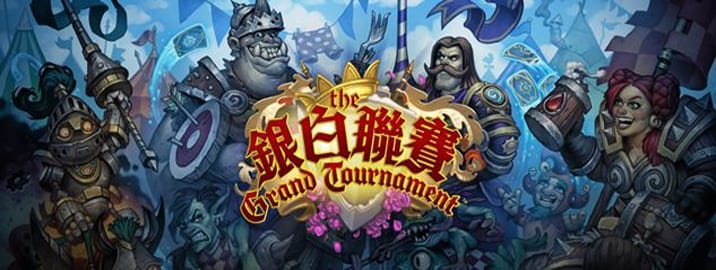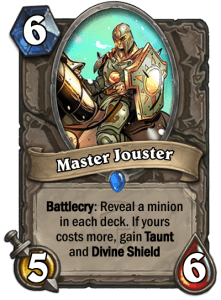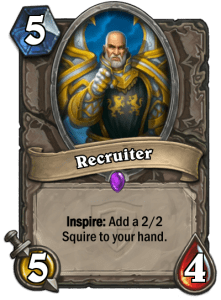
Top 5 Reasons The Grand Tournament was a Horrible, Terrible Set
by JR Cook - 8 years ago show comments
With all the latest Hearthstone announcements about Standard Mode and the new set rotation, I decided to rank all the Hearthstone adventures and expansions to determine the hits and misses of the developers. To the surprise of nobody, TGT came dead last in my ranking, and today I’ll be explaining why I feel so strongly about TGT being Hearthstone worst expansion to date.
5 – Not Enough Cards

This might feel like a weird point to make, especially if we consider that TGT’s 132 collectible cards are the highest number for a Hearthstone expansion yet. So how can the biggest set be bad because it didn’t have enough cards? Well, Hearthstone has been notorious for not introducing enough cards, historically Hearthstone has been quite conservative on its moves. Blizzard hasn’t really implemented radical changes, they’ve been shaping up this game with very small increments. And who can blame them? After all, they stumbled into a gold mine with Hearthstone. Why would you risk that? Especially when you don’t really have a lot of experience with Card Games, being careful is smart. But with 3 expansions released already, I expected Blizzard to up the ante and release a bigger set that had a heavy impact in the meta. Oh boy, I couldn’t have been more disappointed. I was expecting something in the neighborhood of 200 collectible cards with a good percentage of them being suitable for competitive play. Instead….well, you know the story.
4 – Mysterious Challenger

“Who am I? None of your business”
When Mysterious Challenger was revealed, I was probably kinda excited about it. The Mysterious Challenger had the potential to create an entire new deck archetype, it had the potential to turn the irrelevant Paladin secrets into a force to be reckoned with. That seems like good some very good design, but sadly the Mysterious Challenger brought these goodies at a high cost.
It’s one thing when you create a group of cards that all have synergies with lesser cards, and make them relevant in the context of that particular deck. When you have lots of different cards that have synergies, you get a dash of consistency. Consistency is something highly desired in a card game, where the “luck of the draw” is something you can’t avoid, only mitigate. Sadly, Mysterious Challenger based-decks are extremely powerful and relevant, but also very inconsistent.
Having that much power in a single card is something that can easily become problematic. Usually, these powerful cards are balanced by requiring some sort of activator. Either you need to have a specific board state for them to get their full power, or you need to build your deck in a way where you have to use specific cards in order for your big power card to shine. In this particular case, the logic was that in order for you to take advantage of this horrendously powerful card, you have to add a lot of low value cards to your deck. This way, even if you put a highly strong card in the deck, the deck will overall still be balanced.
The big problem with Mysterious Challenger it that it kinda circumvents it own balance counter-measure. By taking the secrets out of your deck, and putting them immediately into the field, you no longer have those low value cards in your deck. In fact, after you play Mysterious Challenger, the average value of your top-deck skyrockets. So in the end we ended up with a deck that’s probably a tad more powerful than it should be, but more importantly we have a deck that can at some times feel really, really unstoppable, and that some times will beat itself. That’s not fun, nor interactive, if I wanted to play against my opponent’s luck, I’d probably spin the wheel or whatever.
3 – Joust

The Joust Mechanic was one of the coolest things introduced in The Grand Tournament. Basically, both you and your opponent reveal cards from your deck and the higher mana cost one wins the jousts. A lot of cards used this mechanic, and it really felt like something that had a lot of potential, but it really didn’t turn out to be a very hot addition to the game.
Lets start by taking a look at the reasons why Joust seemed like a positive thing. First of all, it gives both players extra information, that should reward the most skilled player, right? Second, it looks like something that would influence your deck building. A joust heavy deck would reward a heavier curve, it would want to be the kind of deck that uses spells to hold out the early game; a joust heavy deck would likely want to use cards that have cost reduction built into them, like the Volcanic Drake or some of the Giants. Sadly, building an good early game that’s mainly based on spells is easier said than done, and even if you are able to build a deck that consistently hangs on to the early game by controlling the board with spells, the jousters weren’t really powerful enough to build that kind of gimmick deck.
I looked at the Joust mechanic a long while ago, and I even created my own cards that would have synergy with Joust, just to showcase the kind of cards that would make a Joust concept deck something worth consider. But the main problem with Joust is that Blizzard didn’t create support for Jousting themes, they kinda just threw some Joust cards out there and called it a day, the problem is that by themselves, these cards are just way too inconsistent.
But there’s a big reasons for the Inconsistency with Joust cards, and that’s the fact that Hearthstone is a really tight game. In Hearthstone, a few extra points of stats or extra abilities can quickly turn a bad or average card, into a really good one. This is a game where a key advantage in the early game can really snowball a game and put it out of reach. I talked at length about the Master Jouster earlier this week, and it’s really easy to see it there. If you lose the joust then you played a really bad minion, if you win the joust, you played a really good minion. If you really needed that taunt to survive, you better hope luck was on your side, but leaving that to coin flips will often make you wish you just had your trusty Sludge Belcher instead.
2 – Inspire

But Joust wasn’t the only new mechanic that was more of a hit than a miss. The main theme of this expansion was to make your Hero Power more relevant, which once again seemed like a great idea, but after the set was released, it didn’t really live up to its potential.
The biggest problem with Inspire is that using your hero power is usually quite a big tempo loss. We kinda covered it on this week’s Mending Mondays, where we looked at the Garrison Commander. Generally, using your Hero Power is something that you don’t want to do. Especially on the early game, you want to play on curve. Sure, Hero Powers might be situationally useful, but lining those golden opportunities with having the proper inspire cards isn’t exactly easy.
The thing with these cards is that they feel like either their inspire ability is too weak to warrant the two mana investment of the Hero Power. Or you have super strong abilities like the Kodo Rider, Confessor Paletress, or even the Murloc Knight, and Nexus Champion Saraad. Those are the kind of abilities that can completely take over games if left unchecked. It is that kind of power that requires the base form of these cards to be way to weak, to the point that the cards become either too slow to make a significant impact on the meta, or that they aren’t likely to survive enough turns to get the value you need out of them.
Personally, I don’t think Inspire is an inherently bad mechanic. I really think its quite better than the randomness of the Joust, but the thing is that Inspire proved to be a very difficult mechanic to balance, and it looks like the Blizzard balance team wasn’t quite ready for this yet. Hopefully in the future we can see a triumphant return of the inspire mechanic, with better balanced cards and even more cards that synergize with Hero Powers and make Inspire based decks a thing.
1 – The Grand Dustament

But the biggest problem of all was the overall card quality. To put it bluntly, TGT was a really underpowered set that wasn’t really worth buying. Sure, you had a few excellent cards here and there, but you could simply craft those and move along. Out of the 132 collectible card, I’d be surprised if you can name 30 of them that are really good and competitive. I’m almost confident that League of Explorer introduced a higher quantity of cards to the competitive metagame, and LoE was just a little adventure.
Oh well, at least it looks like Blizzard learned its lessons here, as they followed this up with their best expansion yet.
What do you think about The Grand Tournament? Was this assesment accurate or just plain wrong? Did you think TGT was a good set? Or maybe you have reasons of your own that this expansion wasn’t up to par? Share it with us using the comment section below.

Good points here which tie into your mending mondays. I can only think of about a dozen cards I see in tournament play, which is <10% of set. The only Joust I use is Elekk since it is just a strictly better raptor with the chance to pull your highmane/boom. Inspire has Murloc Knight, maybe valiant and maybe confessor but those are usually not in the popular decktypes for their classes.
While already strong classes, like Paladin & Mage can benefit from Inspire, the mechanic is really awkward for Warlock (where it costs health) and Rogue (where you don’t necessarily want to use hero power every turn especially with weapon buffs).
Although for Warlock it could benefit from a low cost, specifically 1 drop type minion. Handlock turn 1 drop Angry Imp, turn 2 3 tap, turn 4 giant/drake. if it gained 1/1 or generated more Imps that would potentially be useful. For Rogue they basically made an inspire weapon, but its stats still weren’t good enough to use when they want more spell slots.
Set will be “better” when standard hits. A lot of these cards that have been overlooked because there were better options in GVG and Naxx will start coming being played. I actually expect Inspire to see a lot of play with standard depending on what they nerf in the classic set (and what’s coming in the new set).
The main reason: Varian Wrynn. This card suuuuuuucks! I bet that when they were developing the set, they created Varian and hyped a lot about a powerful card and then balanced the set creating shitty cards or unreliable mechanic.
Your joust fixing ideas are awesome btw, when I first saw them, I thought that Blizzard saw them too and fix it for the next set.
4 – Paladin needs some risky secrets that you might want to play, but not with Mysterious Challenger. Something like Cast humility on all minions when you hero is attacked.
3 – Jousts are too unreliable.
2 – They played it too safe on the majority of inspires (which is understandable some some get evil if you get multiple plays or you have several on the board at the same time), but they weren’t helped by having aggro decks being so prevalent. I think team 5 were hoping that Jousts would slow the meta, making inspire more valuable.